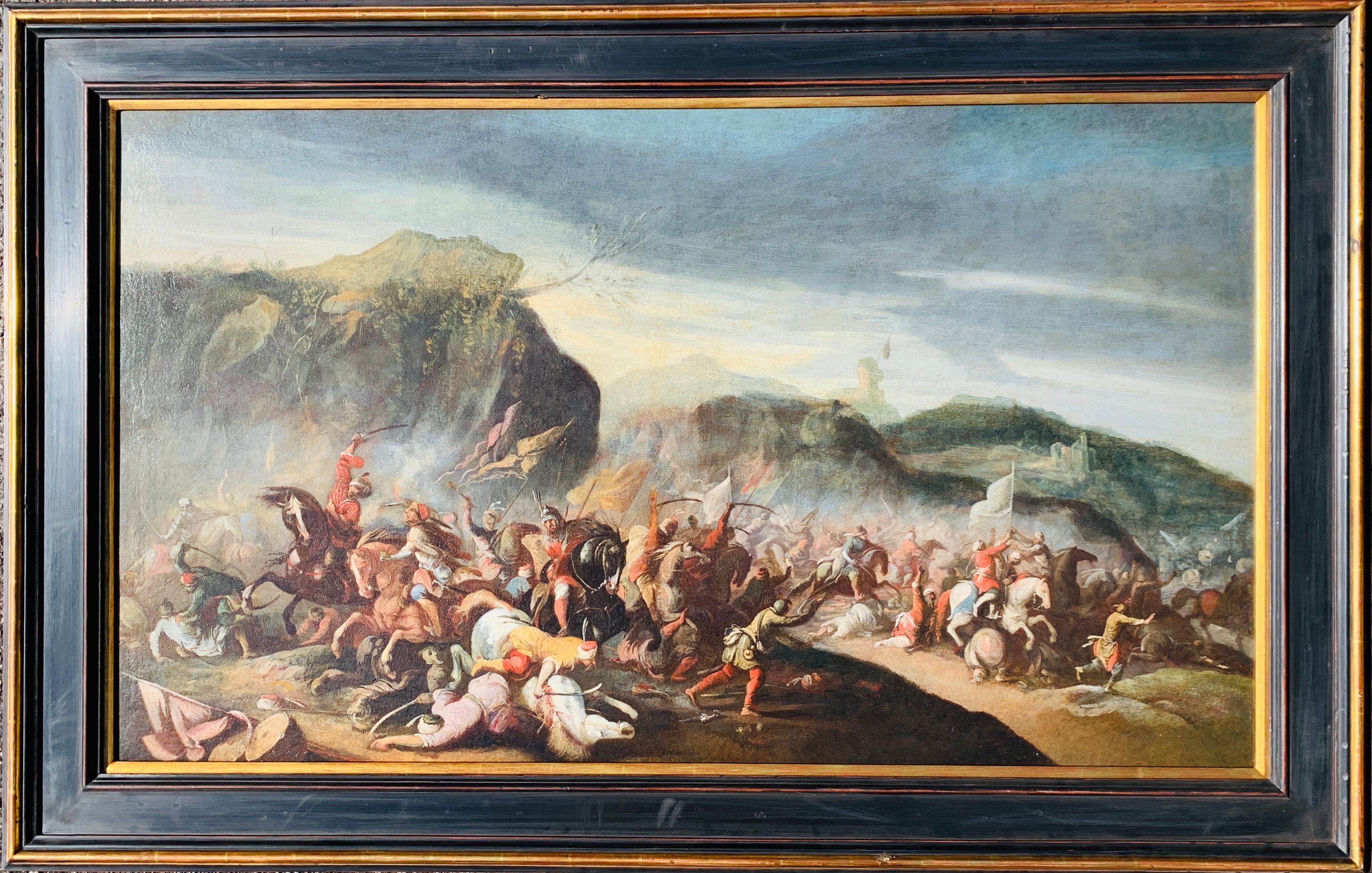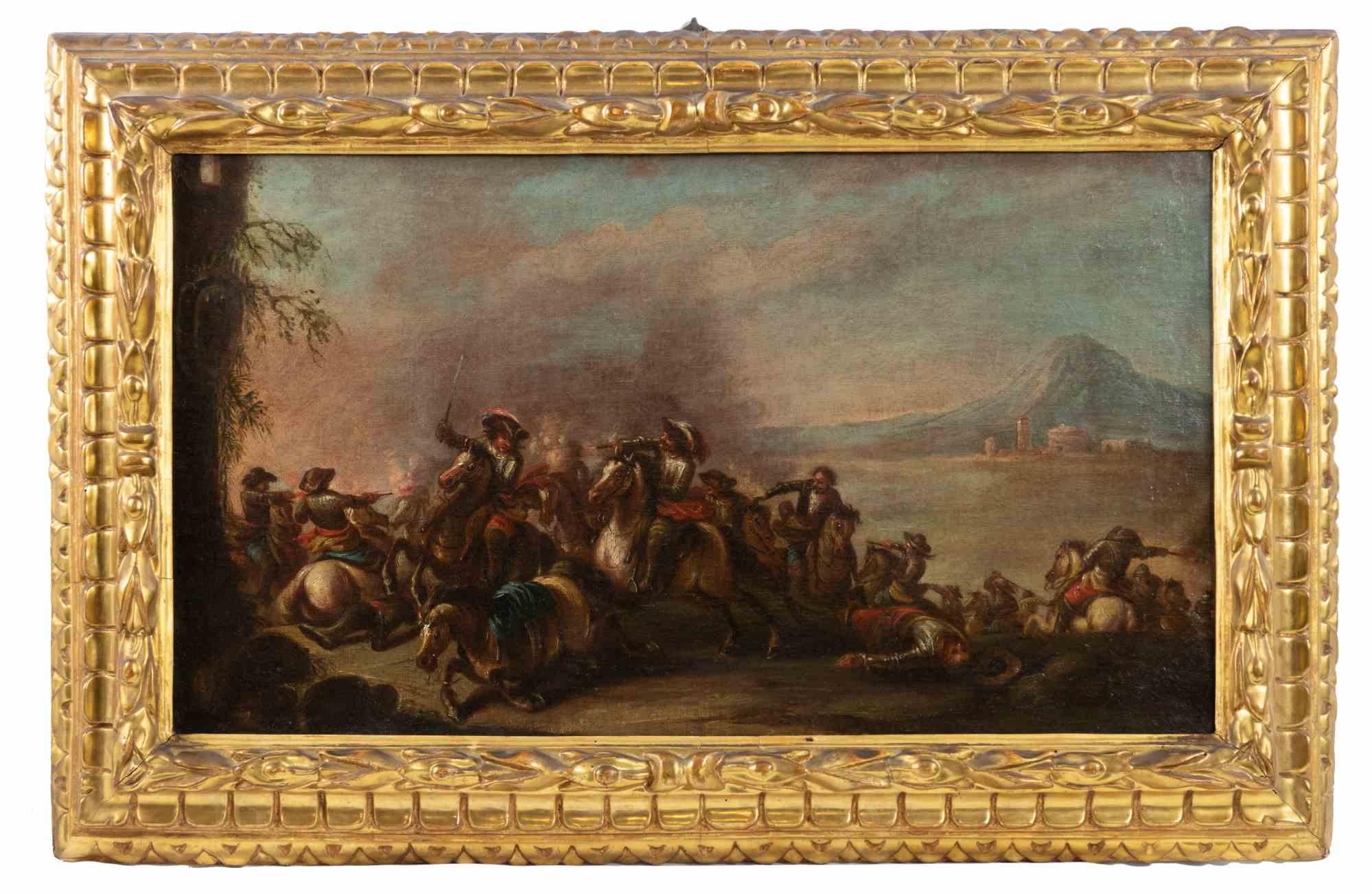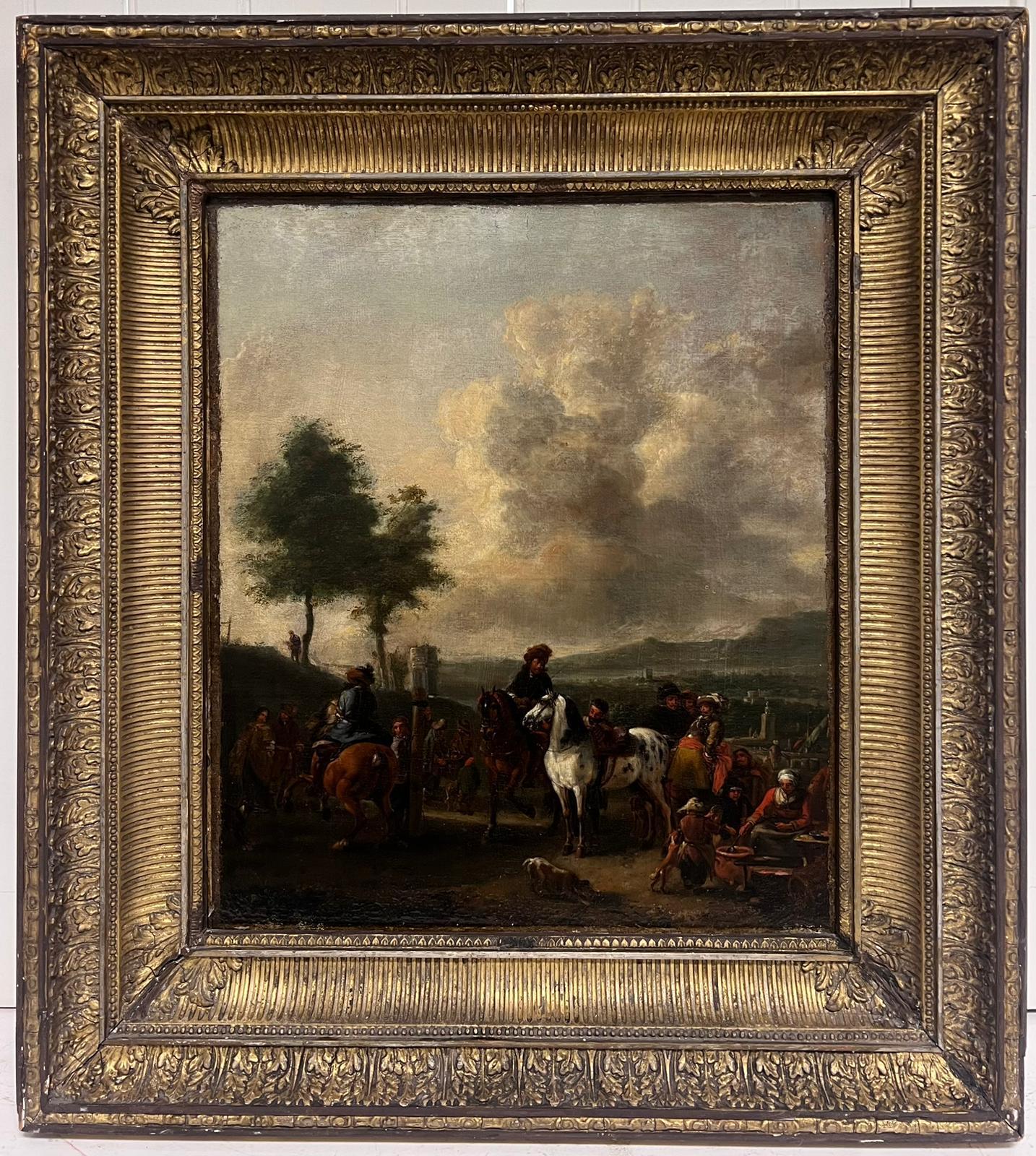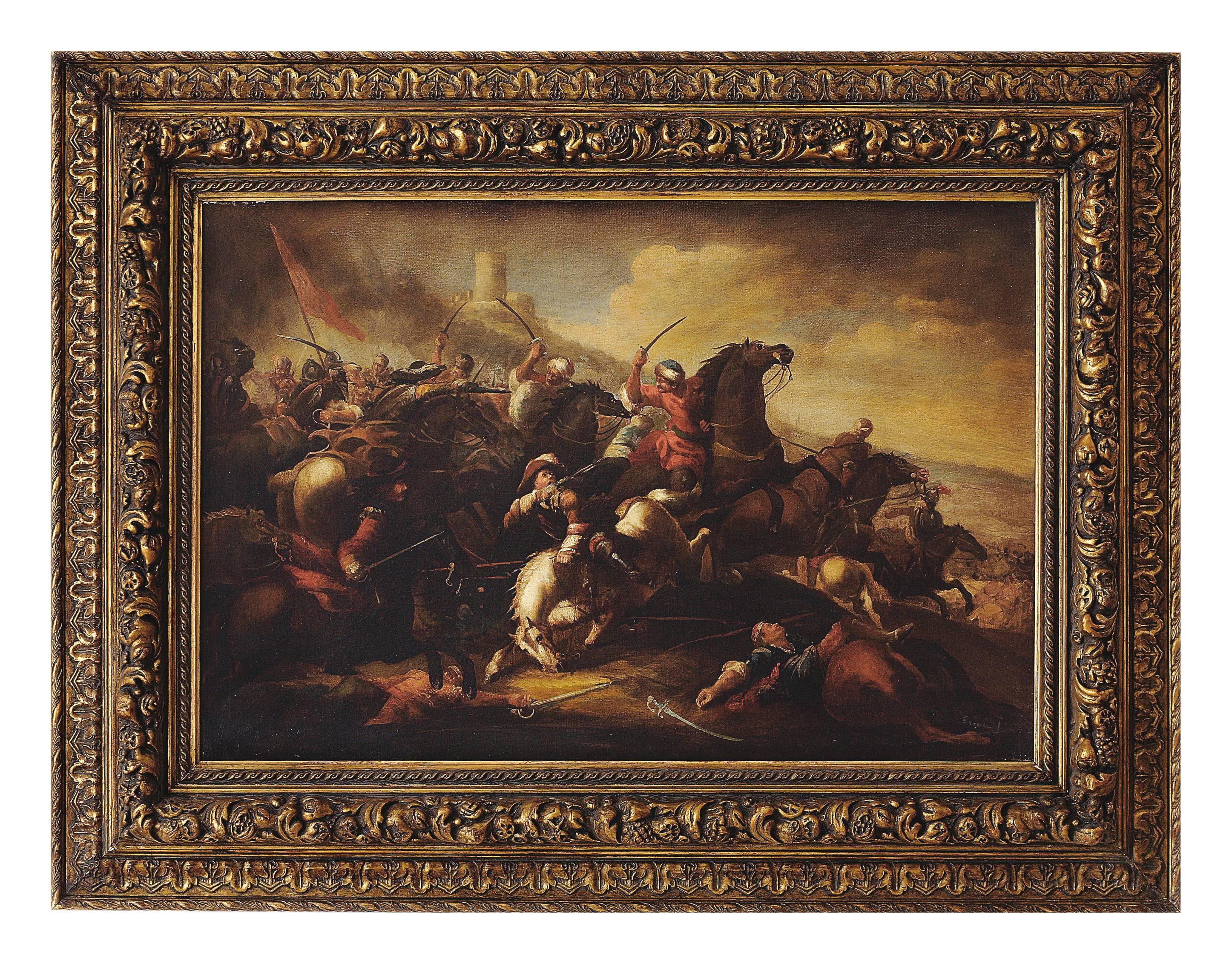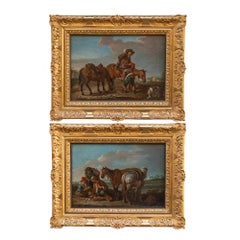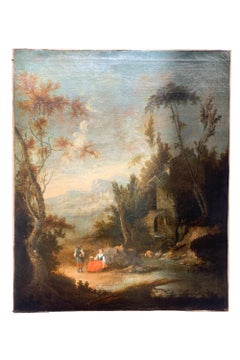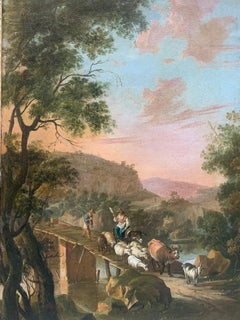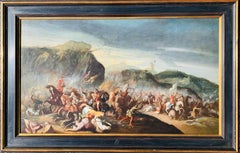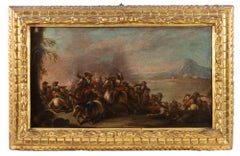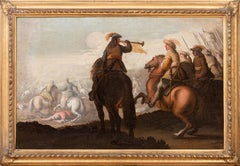Articoli simili a Military Camp Scene and Battle. Pietro Graziani (XVII/XVIII secolo), entourage
Vuoi altre immagini o video?
Richiedi altre immagini o video al venditore
1 di 17
Military Camp Scene and Battle. Pietro Graziani (XVII/XVIII secolo), entourage
2168,98 €IVA inclusa
3500 €40% in meno
Spedizione
Recupero del preventivo…La promessa 1stDibs:
Garanzia di autenticità,
Garanzia di rimborso,
Annullamento entro 24 ore
Informazioni sull’articolo
Military Camp Scene and Battle.
Pietro Graziani (XVII/XVIII secolo), entourage.
A pair ( two) of small paintings.
Cornici antiche del XIX secolo in legno dorato.
In buone condizioni.
Olio su tela.
Tela ribattuta
Dimensioni con cornice: H. 34 cm x L. 26 cm.
Dimensioni senza cornice H. H. 26 cm x L. 17 cm
Both paintings have the same size, and are painted by the same artist.
In one of the paintings we see a messenger pointing to a horseman with his hand at some movements he has just seen, or bringing news of losses. The scene conveys a sense of the speed of what is happening; in the distance, we can see clouds of smoke, the outlines of banners against the background of blue distances, a city in the distance, a hilly landscape. The horseman is dressed in armor, his helmet has feathers, as does the horse's uniform. In the background, we can see a recently overturned cart, traces of violent and brutal battles.
In the second work, the scene unfolds in a military camp, with tents, where an escape and pursuit of a man in a turban and colorful clothes of the Eastern style takes place, possibly a Turk trying to steal the banners. Behind him, a warrior on a horse has already raised his sword to stop the fugitive.
In both compositions there is a sense of speed, time, speed are felt very sharply. The intensity and lightning speed of what is happening are masterfully embodied in the painting technique: before us is almost a sketch in technique, each of the brush strokes is a bundle of emotion and movement. These painting techniques are very bold and foreshadow the painting of a later period. But they certainly draw on the traditions of Neapolitan painting, especially Salvator Rosa, an extraordinary artist, as well as a poet and philosopher.
FRANCESCO AND PIETRO GRAZIANI
There were 2 painters active in Naples and Rome between the end of the seventeenth century and the beginning of the eighteenth century.
Con l'appellativo di "Ciccio Graziani", o più semplicemente "Ciccio Napoletano", sono state elencate, fin dal XVIII secolo negli inventari di famose collezioni private, poi in parte divenute pubbliche, alcune battaglie di piccolo formato, caratterizzate da un'inconfondibile impronta stilistica ed esecutiva. There are examples preserved in the Florentine museums, the couple of the Galleria Pallavicini in Rome, many others in the well-known museums, Italian, from the Capitolina and the Corsini of Rome, the Bardini in Florence, the Civico di Deruta, to the art galleries of Naples and Prato, as well as many foreigners (Geneva, Grenoble, Nantes, Schleissheim, etc.), up to the Waltes Art Gallery in Baltimore.
I Graziani, citati nelle fonti antiche con la specifica qualifica di "Battaglista", sono chiaramente due: una di queste fonti brevemente da Pietro, dicendo di non sapere se fosse coniuge o figlio di Ciccio Graziano che ha lasciato opere nelle chiese di Roma. This in fact is also remembered by E: Titi, as famous for battles.
Pur dovendo quindi riconoscere con sicurezza l'attività di due battaglisti Graziani, solo omonimi o più probabilmente parenti stretti, entrambi napoletani, se non di nascita almeno di scuola, resta la constatazione incontrovertibile che la maggior parte dei dipinti, oggi riuniti sotto il nome di Ciccio Graziani (o, napoletano), denunciano una matrice tardo-cinquecentesca, già incline a soluzioni settecentesche, avvalendosi dell'inventiva napoletana, dal Falcone al Rosa, decisamente rafforzata dalla conoscenza diretta del Borgognone.
Presentations on clear landscaped backgrounds with eventful and crowded scenes of chivalry, whose characters, outlined with a quick and nervous, almost artificial stroke, anticipate the painting of the eighteenth century,
Both in the smaller format with early anticipation of the rococo taste and in the rapid executive way, which draws inspiration from Neapolitan inventiveness, from the Falcone to Salvator Rosa, reinforced by direct knowledge of the battles of the Borgonone.
Even today, it is often problematic to attempt a distinction between a senior Graziani (Francesco) and a junior (Pietro) on the basis of style and above all more elaborate settings and executions, compared to the others more rapid and concise. As mentioned, the appellation of "Ciccio Napoletano" was probably used since the eighteenth century, by the will of Pietro himself, or for an exquisite practice in the same specific collecting (it usually appears in the Corsini inventories).
- Attribuito a:Pietro Graziani (Italiano)
- Dimensioni:Altezza: 34 cm (13,39 in)Larghezza: 26 cm (10,24 in)Profondità: 3 cm (1,19 in)
- Tecnica:
- Movimento e stile:
- Periodo:
- Condizioni:
- Località della galleria:Firenze, IT
- Numero di riferimento:1stDibs: LU2464214555202
Informazioni sul venditore
4,9
Venditore professionale selezionato
Ogni venditore supera rigorosi standard di autenticità e affidabilità
Fondazione nel 2016
Venditore 1stDibs dal 2023
80 vendite su 1stDibs
Tempo di risposta standard: 6 ore
- SpedizioneRecupero del preventivo…Spedizione da: Firenze, Italia
- Politica di reso
Alcune parti di questa pagina sono state tradotte automaticamente. 1stDibs non può garantire che le traduzioni siano corrette. L’inglese è la lingua predefinita del sito.
Garanzia di autenticità
Nell’improbabile caso in cui si verifichi un problema con l’autenticità di un articolo, contattaci entro un anno per ottenere un rimborso completo. DettagliGaranzia di rimborso
Se il tuo articolo non corrisponde alla descrizione, è danneggiato durante il trasporto o non arriva, contattaci entro 7 giorni per un rimborso completo. DettagliAnnullamento entro 24 ore
Hai un periodo di tolleranza di 24 ore per annullare il tuo acquisto, senza necessità di fornire spiegazioni.Venditori professionali selezionati
I nostri venditori di livello internazionale devono aderire a rigorosi standard di servizio e qualità, garantendo l’integrità delle inserzioni.Garanzia miglior prezzo
Se scopri che un venditore ha pubblicato altrove lo stesso articolo a un prezzo più basso, applicheremo lo stesso prezzo.Consegna globale affidabile
La nostra rete di vettori leader del settore offre opzioni di spedizione specializzate in tutto il mondo, inclusa la consegna personalizzata.Altro da questo venditore
Mostra tuttoBamboccianti Scene di campagna con cavalli e giocatori di carte, Roma circa 1740
Scene di campagna con cavalli e giocatori di carte, Roma, 1740 ca.
Coppia di dipinti: Alt di campagna con cavalli e gioco di carte in campagna
Paolo Monaldi (dopo il 1710 - dopo il 1...
Categoria
Metà XVIII secolo, Scuola italiana, Dipinti (paesaggio)
Materiali
Tela, Olio
Landscape With Hunters By A Lake. XVIII Century.
Landscape with hunters by a lake.
XVIII century.
Oil painting on canvas, from the French or Northern Italian school, Louis XV period.
Probably part of the door decoration in an inter...
Categoria
18th Century, Barocco, Dipinti (paesaggio)
Materiali
Tela, Oil
680 € Prezzo promozionale
20% in meno
Scena pastorale con mulino e paesaggio boschivo, metà del XVIII secolo
Scena pastorale con mulino e paesaggio boschivo, metà del XVIII secolo
Scuola francese
Olio su tela, 86 × 71 cm
La scena si svolge in un paesaggio boscoso attraversato da un ruscell...
Categoria
Metà XVIII secolo, Rococò, Dipinti (paesaggio)
Materiali
Tela, Olio
Ambito di Jan Both ( Utrecht, 1618-1652) Paesaggio Laziale con ponte e pastori
Paesaggio italiano con un ponte, una torre, pastore ed animali.
Ambito di Jan Both ( Utrecht, 1618-1652), arrivo a Roma e Venezia oltre al suo paese natale, Olanda.
Il dipinto del X...
Categoria
17th Century, Scuola olandese, Dipinti (paesaggio)
Materiali
Tela, Oil
2400 € Prezzo promozionale
36% in meno
XVII secolo. Gentiluomo con spada nella fucina di un fabbro.
Gentiluomo con spada nella fucina di un fabbro. Italia, prima metà del XVII secolo
Olio su pannello di noce
Dimensioni del pannello: 22 × 18,5 cm
Cornice: 28,5 × 25 cm (non original...
Categoria
XVIII secolo, Antichi maestri, Dipinti figurativi
Materiali
Noce, Olio, Pannello in legno
The Runaways, o il ragazzo svizzero su Donkey. Attributed to Joseph Hornung.
A couple of young boy and girl, dressed in ethnographic costumes, probably Savoyard, ride a donkey.
The scene takes place in the middle of the countryside with mountains in the back...
Categoria
Mid-19th Century, Romantico, Dipinti figurativi
Materiali
Acciaio inossidabile
584 € Prezzo promozionale
40% in meno
Spedizione gratuita
Ti potrebbe interessare anche
Cavallo italiano del XVII secolo Scena di battaglia tra i crociati e il loro nemico
Di Jacques Courtois
Scena di battaglia delle Crociate, olio su tela, di dimensioni gigantesche, del XVII secolo, French Old Master. Veduta paesaggistica in grande scala di una battaglia del periodo 1670...
Categoria
Fine XVII secolo, Antichi maestri, Dipinti figurativi
Materiali
Olio
13.534 € Prezzo promozionale
20% in meno
Spedizione gratuita
Scena di battaglia - Pittura - 18° secolo
Battle Scene è un'opera d'arte originale di antichi maestri realizzata nel XVIII secolo.
Pittura a olio mista colorata su tela. L'opera d'arte è comprensiva di cornice: 58 x 90 cm.
Categoria
XVIII secolo, Antichi maestri, Dipinti figurativi
Materiali
Olio
Battaglia Cavalieri Paesaggio Graziani Dipinto Olio su tela del 17° secolo Vecchio maestro
Francesco Graziani, noto come Ciccio Napoletano
(attivo a Napoli e a Roma nella seconda metà del XVII secolo)
Battaglia con scontro di cavalieri
Olio su tela
95 x 130 cm
In cornice...
Categoria
XVII secolo, Antichi maestri, Dipinti
Materiali
Olio
9256 € Prezzo promozionale
20% in meno
La carica di cavalleria, guerre anglo-olandesi, XVII secolo Palamedes PALAMEDESZ
La carica di cavalleria, guerre anglo-olandesi, XVII secolo
attribuito a Palamedes PALAMEDESZ (1607-1638)
Grande scena di battaglia del XVII secolo che rappresenta una carica di c...
Categoria
XVII secolo, Dipinti (paesaggio)
Materiali
Tela, Olio
3032 € Prezzo promozionale
35% in meno
Pregevole olio antico olandese del XVII secolo con figure di accampamento militare a cavallo
Di Philips Wouwerman
L'accampamento militare
Scuola olandese, XVII secolo
cerchia di Philips Wouwerman (olandese, 1619-1668)
dipinto a olio su tela, in cornice dorata del XVIII secolo
misure della tela: ...
Categoria
XVII secolo, Antichi maestri, Dipinti (paesaggio)
Materiali
Olio, Tela
BATTAGLIA DI CAVALLERIA - Antonio Savisio - Scuola Napoletana Pittura a olio su tela
Di Antonio Savisio
Battaglia di terra - Antonio Savisio Italia 2006 - Olio su tela cm.60x90.
Cornice in legno dorato a foglia d'oro cm.92x122
Il Maestro Antonio Savisio si è ispirato ai capolavori de...
Categoria
Inizio anni 2000, Antichi maestri, Dipinti figurativi
Materiali
Tela, Olio
